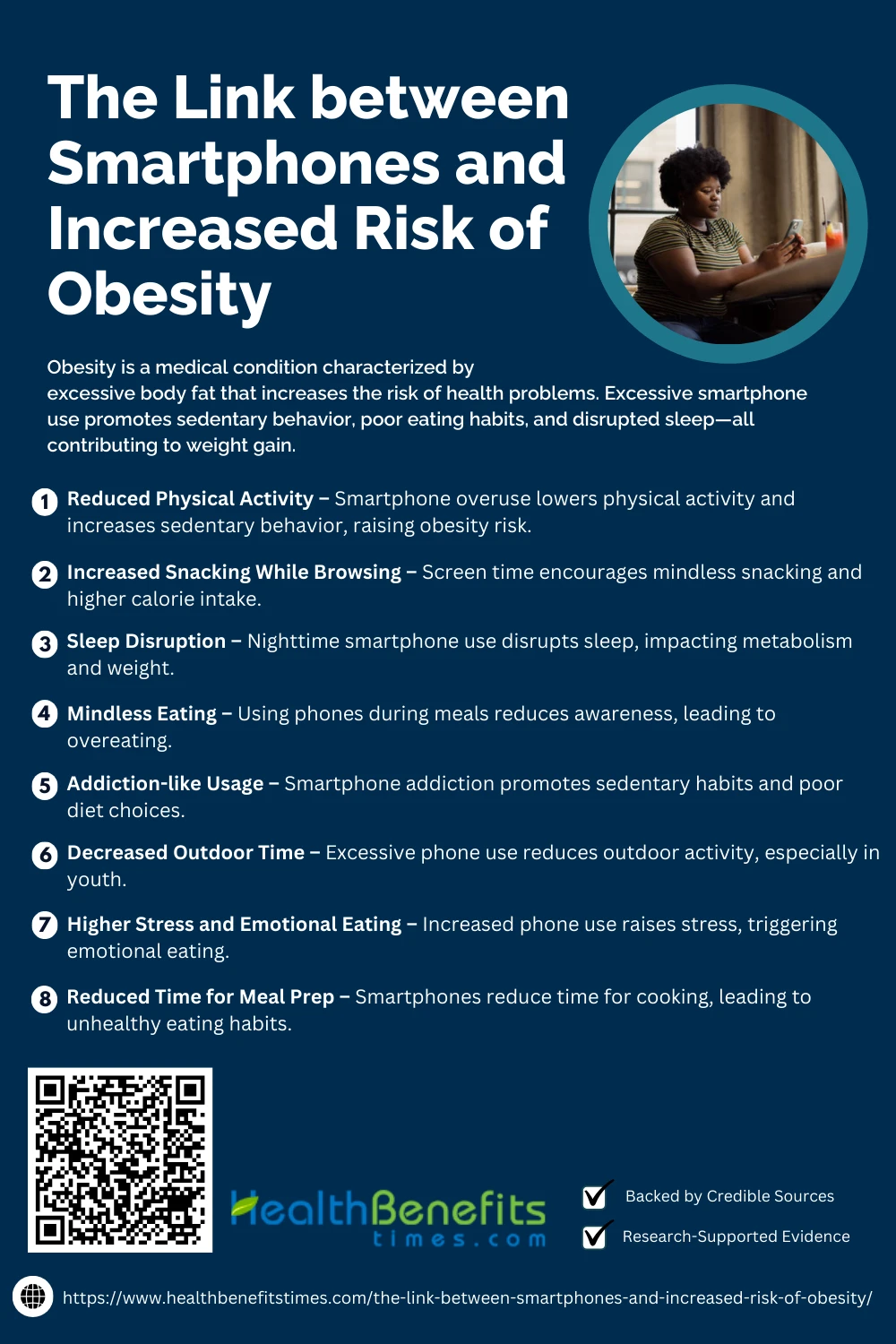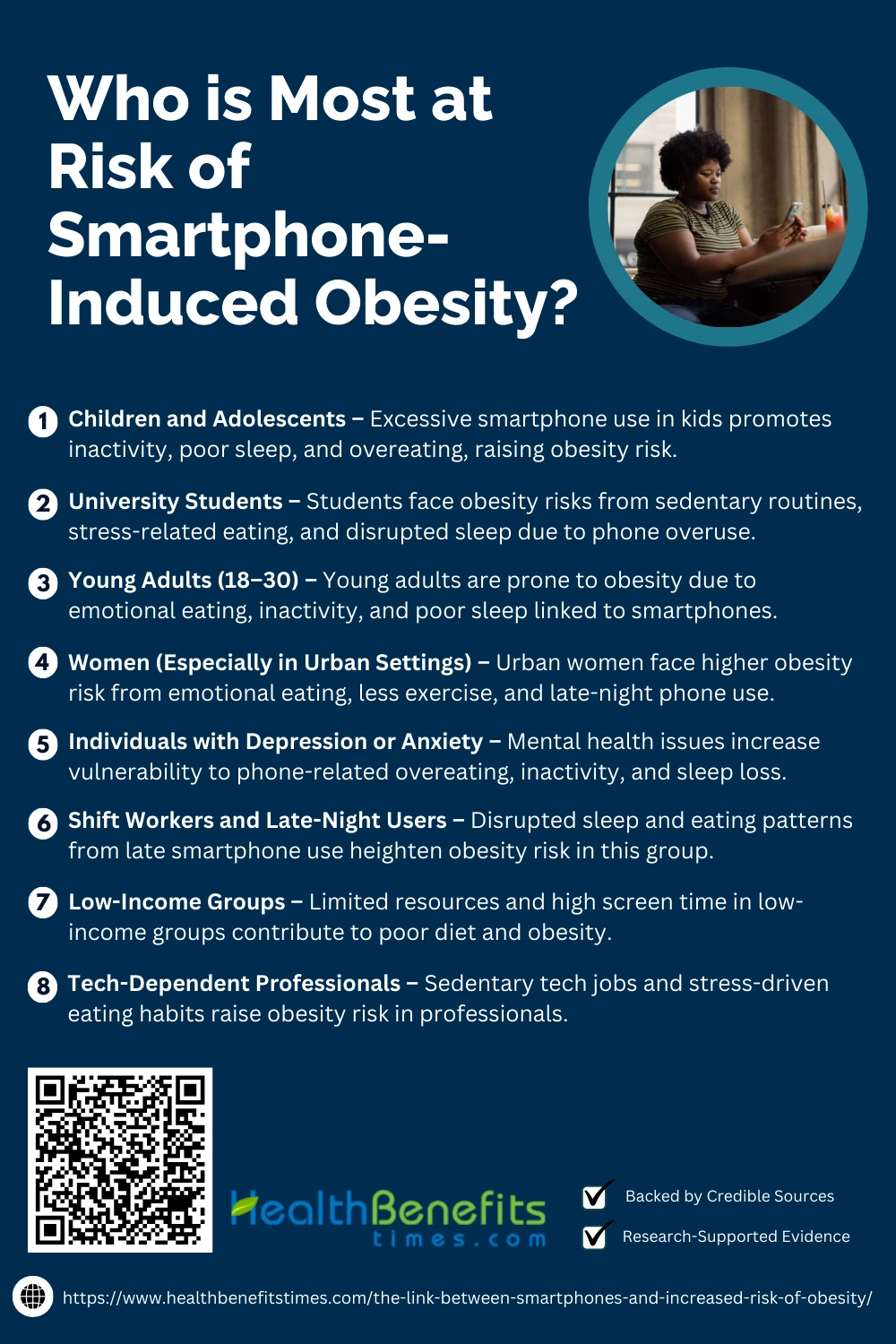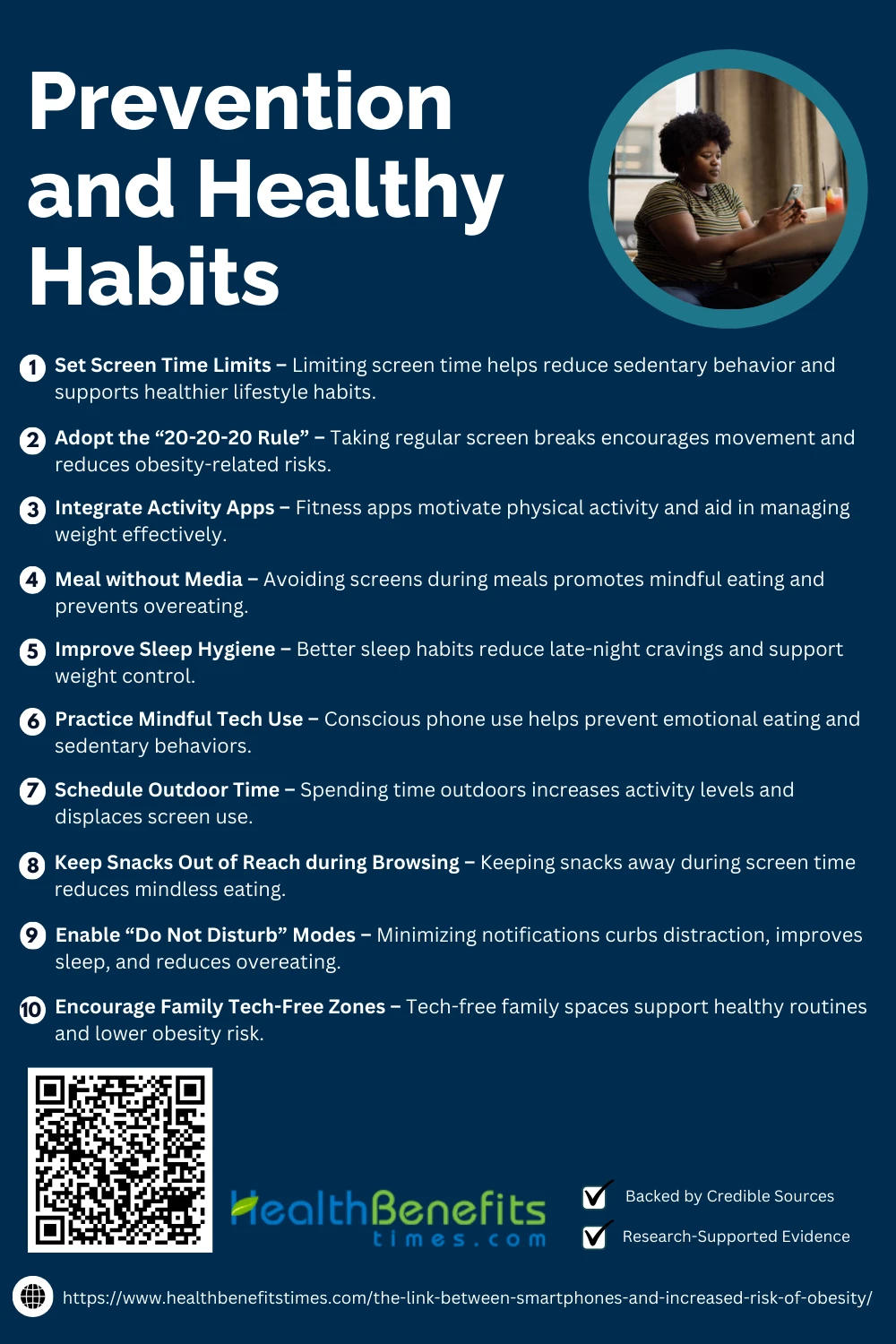- Obesity is a medical condition characterized by excessive body fat that increases the risk of health problems.
- Excessive smartphone use promotes sedentary behavior, poor eating habits, and disrupted sleep—all contributing to weight gain.
- Understanding the connection between screen time and obesity helps promote healthier lifestyle choices in the digital age.
 Obesity is defined as an abnormal or excessive fat accumulation that presents a risk to health, commonly measured using Body Mass Index (BMI). In today’s digital age, smartphones have become indispensable, transforming the way people communicate, work, and entertain themselves. However, emerging research suggests a troubling association between increased smartphone use and the rising prevalence of obesity. Studies have found that excessive screen time is often linked to sedentary behavior, sleep disruption, and increased snacking—factors contributing to weight gain. For instance, one large-scale cross-sectional study found a strong correlation between prolonged smartphone use and obesity among young adults, especially those engaging with devices more than five hours a day. Furthermore, digital distractions often promote mindless eating, where individuals are unaware of portion sizes or hunger cues, exacerbating the risk.
Obesity is defined as an abnormal or excessive fat accumulation that presents a risk to health, commonly measured using Body Mass Index (BMI). In today’s digital age, smartphones have become indispensable, transforming the way people communicate, work, and entertain themselves. However, emerging research suggests a troubling association between increased smartphone use and the rising prevalence of obesity. Studies have found that excessive screen time is often linked to sedentary behavior, sleep disruption, and increased snacking—factors contributing to weight gain. For instance, one large-scale cross-sectional study found a strong correlation between prolonged smartphone use and obesity among young adults, especially those engaging with devices more than five hours a day. Furthermore, digital distractions often promote mindless eating, where individuals are unaware of portion sizes or hunger cues, exacerbating the risk.
The Rise of Smartphone Use
Smartphone usage has skyrocketed across all age groups, with over 95% of young adults (18–29) and 83% of those aged 30–49 owning smartphones in the United States. Even among older adults (65+), adoption is steadily rising, reaching 61% in 2024. This widespread adoption spans generations, signaling a fundamental shift in how people engage with technology.
On average, people now spend 6 hours and 37 minutes per day on mobile devices, a figure that continues to climb globally. This screen time includes everything from browsing and messaging to streaming content and playing games—activities that often displace physical movement and real-world interactions.
Smartphones have also become central to work, entertainment, and socialization, enabling remote jobs, video conferencing, content creation, and social media engagement. The result is a powerful dependency on digital platforms that shapes daily routines.
What are link between Smartphones and Increased Risk of Obesity?
Smartphones have transformed daily life, but their excessive use may contribute to rising obesity rates. Reduced physical activity, poor eating habits, and disrupted sleep are key factors linking smartphones to weight gain.
Smartphone overuse significantly reduces physical activity levels, leading to increased sedentary behavior and obesity risk. Research shows that excessive screen time is linked with lower step counts and higher BMI in adolescents. (1) A longitudinal study found a strong association between mobile device usage and physical inactivity. (2) Additional evidence highlights the negative impact on sleep and metabolic health, worsening obesity. Studies also demonstrate that screen-based entertainment replaces active leisure time, and walking interruptions due to texting further contribute to reduced energy expenditure. (3)
2. Increased Snacking While Browsing
Smartphone multitasking during screen time is linked with mindless eating and increased calorie intake. Research reveals that media multitasking often leads to distracted eating habits. (4) A recent experiment found that snacking while browsing on phones increased energy consumption. (5) Moreover, smartphone-induced distraction lowers dietary self-regulation, while push notifications from food delivery apps elevate cravings. Additional studies confirm that screen exposure stimulates hunger cues and reduces meal awareness, heightening obesity risk. (6) (7)
3. Sleep Disruption
Prolonged smartphone use before bedtime disrupts circadian rhythms and reduces sleep duration, a key factor in obesity development. Blue light exposure inhibits melatonin production, impairing sleep quality and metabolic health. Studies confirm that nighttime phone use increases sleep disturbances, which heighten obesity risk. Research shows reduced REM sleep due to smartphone exposure. (8) Additionally, shorter sleep has been directly linked to elevated BMI, appetite dysregulation, and hormonal imbalance. (9) (10) (11)
4. Mindless Eating
Using smartphones during meals leads to distracted eating, which reduces food awareness and promotes overeating. Research has shown that multitasking with phones significantly increases caloric intake. (12) Disrupted focus reduces portion control and increases cravings for energy-dense foods. (7) Evidence also links smartphone use with emotional eating patterns and low interoceptive awareness. (6) Notifications and screen distractions trigger habitual snacking, intensifying obesity risk factors.
5. Addiction-like Usage
Smartphone overuse mimics addictive behaviors that reinforce sedentary patterns, potentially increasing obesity risk. (13) The dopamine-driven feedback loop of mobile applications reduces motivation for physical activity. (14) Studies show compulsive smartphone usage correlates with elevated BMI and poor dietary choices. (15) Moreover, late-night screen exposure disrupts sleep cycles, contributing to weight gain. These behaviors collectively impair metabolic health, particularly in adolescents and young adults.
6. Decreased Outdoor Time
Excessive smartphone use is linked to decreased outdoor activity, significantly increasing obesity risk in children and adolescents. Reduced physical activity due to screen time limits calorie expenditure, and this sedentary behavior displaces active play. (16) (17) Additionally, light exposure reduction from staying indoors affects metabolic regulation. The correlation between screen time and higher BMI is evident in youth. Moreover, smartphone-related displacement of outdoor exercise amplifies this concern.
7. Higher Stress and Emotional Eating
Excessive smartphone use has been linked to higher stress levels, which often triggers emotional eating behaviors. (18) These behaviors are particularly common in adolescents, where screen time exacerbates stress-induced eating patterns. Additionally, studies have shown that increased smartphone dependency correlates with greater psychological distress and poor diet quality. (19) The link between stress and overeating is well-documented, further supporting that stress-related smartphone use may contribute to obesity risk. (20)
8. Reduced Time for Meal Prep
Smartphone overuse can displace time typically allocated for healthy meal planning, contributing to poor dietary habits. Research shows that screen engagement reduces home cooking frequency, resulting in greater reliance on processed food. (21) In adolescents and young adults, screen time has been associated with skipping meals, and ordering takeout more frequently. (22) Smartphone distraction also diminishes mindful eating, further fueling the obesity epidemic. (23) (24)
Who is Most at Risk of Smartphone-Induced Obesity?
Certain groups are more vulnerable to smartphone-related obesity risks. Children, teens, and office workers often experience reduced activity, poor dietary habits, and sleep issues due to prolonged screen time and digital dependency.
Children and adolescents face increased obesity risk due to excessive smartphone use, which promotes sedentary behavior, reduces outdoor play, and encourages mindless eating. (25) (24) Screen time also disrupts sleep cycles, contributing to metabolic imbalance and weight gain, as shown in longitudinal studies. (26)
2. University Students
University students are particularly vulnerable to obesity linked to smartphone overuse due to sedentary academic routines, disrupted sleep from late-night use, and emotional eating triggered by stress. (13) Studies show smartphone addiction in students correlates with poor diet and weight gain, emphasizing the health implications of tech-heavy lifestyles. (15)
3. Young Adults (18–30)
Young adults aged 18–30 are particularly vulnerable to smartphone-induced obesity due to sedentary screen engagement, irregular eating patterns, and disrupted sleep. (27) This age group exhibits a strong link between smartphone use and emotional eating, as well as reduced physical activity, contributing to increased obesity risk. (14) (28)
4. Women (Especially in Urban Settings)
Urban women face elevated obesity risk from smartphone overuse, which amplifies emotional eating habits, reduces time for physical activity, and increases reliance on processed food. (15) Additionally, frequent late-night phone use disrupts sleep, affecting metabolic health and weight control.
5. Individuals with Depression or Anxiety
People with depression or anxiety are highly susceptible to smartphone-induced obesity due to excessive screen use, emotional eating, and poor sleep patterns. (18) (29) These behaviors form a feedback loop that worsens mental health and promotes unhealthy weight gain, especially in tech-reliant environments.
6. Shift Workers and Late-Night Users
Shift workers and night-time smartphone users experience disrupted circadian rhythms, metabolic disturbances, and sleep deprivation—all linked to obesity. Increased late-night screen time contributes to reduced physical activity and poor diet, making this group particularly vulnerable to technology-induced weight gain. (20)
7. Low-Income Groups
Low-income populations are disproportionately affected by smartphone-induced obesity due to limited access to nutritious food, higher sedentary screen time, and reduced opportunities for physical activity. (30) Economic constraints often lead to increased fast-food reliance, compounding the health impact of prolonged smartphone usage.
8. Tech-Dependent Professionals
Tech-reliant professionals are at high risk of obesity from prolonged sedentary screen exposure, reduced exercise, and stress-induced irregular eating habits. (27) Heavy smartphone use also correlates with poorer sleep quality, all of which contribute to unhealthy weight gain in desk-bound careers. (13)
Prevention and Healthy Habits
Preventing smartphone-induced obesity starts with awareness and balanced habits. Setting screen time limits, staying active, eating mindfully, and improving sleep can help counter the negative effects of excessive smartphone use.
Limiting screen time is an effective strategy to combat smartphone-induced obesity by reducing sedentary behavior and promoting healthier routines. Research shows that screen overuse is directly linked to higher obesity rates in both children and adults. (25) Implementing screen time restrictions has been associated with improved physical activity levels and better dietary choices, making it a critical preventive measure in digital wellness efforts. (15)
2. Adopt the “20-20-20 Rule”
The “20-20-20 Rule”—taking a 20-second break every 20 minutes to look 20 feet away—not only prevents eye strain but also interrupts prolonged screen time, which contributes to obesity. Breaks encourage movement and reduce sedentary screen exposure. (27) Such micro-activities are linked to lower BMI and enhanced metabolic health, especially in tech-heavy lifestyles. (28)
3. Integrate Activity Apps
Using smartphone-based activity apps can effectively counteract sedentary behavior and support weight management. Studies show that mobile health tools increase physical activity engagement and promote behavior change. (24) Fitness apps also help users set goals and track steps, contributing to reduced BMI. (20) Moreover, gamified features in apps have been shown to enhance motivation for movement, especially in young and tech-savvy populations.
4. Meal without Media
Avoiding smartphone use during meals encourages mindful eating and prevents overeating. Research reveals that screen distractions while eating are linked to greater caloric intake. (23) Disconnecting during meals enhances satiety recognition and improves dietary quality. (27) Additionally, screen-free eating has been shown to reduce obesity risk by supporting conscious food choices and fostering healthier mealtime behaviors. (15)
5. Improve Sleep Hygiene
Improving sleep hygiene is essential in preventing smartphone-induced obesity, as late-night screen exposure disrupts circadian rhythms and reduces sleep quality. Poor sleep increases cravings for unhealthy foods and decreases physical activity the next day. Establishing screen-free bedtime routines has been linked to lower obesity risk, highlighting the importance of consistent sleep schedules and nighttime tech boundaries. (20)
6. Practice Mindful Tech Use
Mindful technology use helps reduce the unconscious behaviors that lead to smartphone-induced obesity. Being aware of digital habits can lower compulsive phone use and promote better lifestyle choices. (15) Mindfulness practices are also associated with healthier eating and improved emotional regulation, which in turn support weight management by reducing stress-induced snacking and screen-time-related inactivity. (18)
7. Schedule Outdoor Time
Scheduling outdoor time reduces sedentary behavior and promotes physical activity, key factors in preventing smartphone-induced obesity. Studies show that regular outdoor play is linked to lower BMI and better cardiovascular health. Nature exposure also improves mental well-being, which can reduce emotional eating. (28) Importantly, outdoor engagement displaces screen time, reinforcing active and tech-balanced lifestyles. (25)
8. Keep Snacks Out of Reach during Browsing
Unconscious snacking while using smartphones significantly contributes to weight gain. Research shows that multitasking with screens leads to increased caloric intake. (23) Keeping snacks physically out of reach during browsing promotes mindful eating and reduces impulsive consumption. This small behavior change helps mitigate emotional eating and supports healthier dietary patterns in tech-intensive daily routines. (15)
9. Enable “Do Not Disturb” Modes
Activating “Do Not Disturb” modes can significantly reduce screen interruptions that lead to sedentary behavior and mindless snacking. (23) Reduced notification exposure improves focus and sleep quality, lowering stress-related food consumption. Additionally, studies show that managing smartphone use leads to better weight control by minimizing compulsive engagement and preserving time for active, health-promoting behaviors. (18)
10. Encourage Family Tech-Free Zones
Creating tech-free zones during meals and bedtime strengthens family routines and reduces smartphone overuse, a key driver of sedentary lifestyle. (27) These zones foster face-to-face interaction, enhance mindful eating, and improve sleep hygiene by limiting evening screen time. (15) Evidence supports that family digital boundaries contribute to lower obesity rates, particularly in children and adolescents.
Conclusion
The growing dependence on smartphones has undoubtedly changed how we live, but it also brings hidden health risks—one of the most concerning being its connection to rising obesity rates. From encouraging sedentary lifestyles and mindless eating to disrupting sleep and increasing stress, excessive smartphone use can negatively impact overall health. Recognizing these patterns is the first step toward change. By setting screen-time boundaries, staying physically active, and being mindful of our digital habits, we can reduce these risks. Embracing a balanced lifestyle allows us to enjoy the benefits of technology while protecting our long-term health and well-being.





